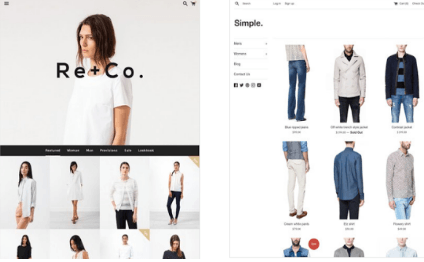Building an online store is easier today than it ever has been, thanks to the abundance of e-commerce website templates. You have a vast number of high-quality website templates to choose from, both paid and free. The paid or comxmercial ones usually come with more advanced features than the free options.
However, you can still do a lot with free website templates. If you’re planning to use a one of these for your e-commerce website, here’s what you need to do.
Step 1# Find A Template Based On Your Requirements
Unless you want to run a full-blown enterprise store, a free website template can fulfil most of your needs. Many sites offer free website templates—we’ve included a list of such services at the end of this article.
Your first job is to browse through these sites and find a template close to you the online store you have in mind.

Shopify lets you choose your e-commerce template

Shopify offers a wide variety of templates on their store
Pay attention to details like product cataloging and payment gateway options. Some templates offer a couple of variants. Before downloading your chosen template, click on the live demo option to see how actually your store will look like. Check the description of the website, its release date, and its size as well.
Make sure the template has a responsive design. Most people use mobile phones to browse the web today, so it’s crucial that your website adjusts to the size of phone screens.
There are numerous ecommerce website templates for free download available out there. Once you’ve found the design you like, click on the ‘download’ button. The templates usually come in .zip archives. You’ll usually have to download a single file for the entire template.
Step 2# Unpack The Template
Once you download the template, you need to unzip the files. Open the folder.
You’ll likely come across three files:
- A file that contains the actual content, like titles, texts, and codes for content images, and the general structure of the template. This is usually an HTML file.
- A stylesheet that shows how the content will look like when seen on the web.
- A sample image, which usually is a wide photo and the header image of the template.
As you unpack the template onto your computer, you’ll be able to browse it much like visitors once your website goes live. You’ll need to edit the template and make the required changes.
Step 3# Customizing The Template
The final step is making changes to the template based on your store requirements. You’ll need to make use of a software program to edit the template. You can either use a visual editor or a code editor.
Using a visual editor is the easiest way. However, they offer less flexibility in terms of editing content. You can only edit what you see on the template, like text content and images. You don’t have access to the codes; overall, this is the best option for someone with zero technical knowledge.
The code editor lets you edit the HTML and CSS codes, which is what the template is made up of. The code is in plain text; you can use any text editor to edit it.
As promised, here are some free e-commerce website templates for you to take a look at.
3 Website Builders Offering Free E-Commerce Website Templates
Shopify
Undoubtedly one of the leaders in this field, Shopify offer a vast collection of free e-commerce website templates. They promise complete control over the design of your store; their templates are full of features and functionalities. You also have the option to choose from custom themes, if you’re not happy with their stock style themes.
Using Shopify to create a website is easy. This service offers it all, from choosing a domain name and registering it to website hosting. Websites created from these templates are search engine optimised, let you track sales, support over 70 payment gateways and multiple languages, and offer features like social media integration.
Wix
Wix also offers you a collection of e-commerce website templates with responsive design. This is a drag-and-drop website builder, and is particularly suited for e-commerce websites just like Shopify.
The website templates come with features like inventory management, and tax and shipping cost calculation. Wix sites also come with social media integration and numerous payment options.
BigCommerce
This online store builder is more suitable for enterprise-level sellers. BigCommerce lets you set up your entire store. It comes with advanced SEO tools, and makes shopping easy for your customers.
There are many website builders like these; your choice depends on what you’re looking for. Compare the features and functionalities offered before you make your decision. Compare prices, support services, and ease of customization.

This is Rohan, I’m a Digital marketing Expert, Full time Content Writer and founder of BoxerTechnology.com I can help people across the world through my articles. I am sharing the latest stories from companies like Apple, Samsung, Google, and Amazon.




Leave a Reply